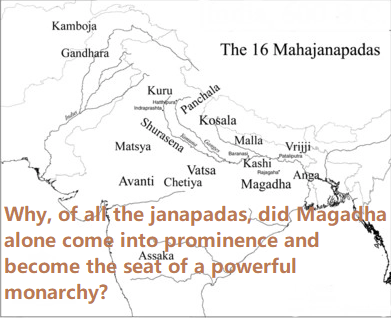Magadha’s rise to prominence and its establishment as a powerful monarchy can be attributed to several key factors, encompassing geographical advantages, economic resources, strategic leadership, and social conditions. Here are the primary reasons:
Geographical Advantages
- Fertile Land: The region of Magadha, located in present-day Bihar, had extremely fertile land, particularly along the Ganges River. This allowed for surplus agricultural production, which could support a large population and a strong army.
- Natural Fortifications: Magadha was protected by natural barriers such as rivers and hills, making it difficult for invaders to penetrate. This geographical advantage helped maintain stability and security within the region.
Economic Resources
- Rich Mineral Resources: Magadha was rich in minerals, especially iron, which was crucial for making weapons and tools. This gave Magadha a technological edge in warfare and infrastructure development.
- Trade and Commerce: The region’s location along major trade routes facilitated commerce and wealth accumulation. Magadha’s rulers were able to tax trade effectively, boosting their revenues.
Strategic Leadership
- Effective Rulers: Magadha was ruled by a series of capable and ambitious kings, such as Bimbisara and Ajatashatru, who pursued aggressive expansionist policies. Their military campaigns and strategic alliances helped expand and consolidate their power.
- Innovative Military Strategies: Magadha rulers employed innovative military strategies and technologies, such as the use of war elephants and fortified cities. These advancements gave them a significant advantage over rival janapadas.
Political and Administrative Innovations
- Centralized Administration: Magadha developed a more centralized and efficient administrative system compared to other janapadas. This included the establishment of a bureaucratic apparatus to collect taxes, enforce laws, and maintain order.
- Diplomacy and Alliances: The rulers of Magadha skillfully used diplomacy to form alliances with other states, securing their position and expanding their influence without necessarily engaging in constant warfare.
Social and Religious Factors
- Support from Religious Figures: The rise of Buddhism and Jainism in the region provided Magadha with a degree of religious legitimacy. Prominent figures like Gautama Buddha and Mahavira spent significant time in Magadha, attracting followers and enhancing the region’s cultural and religious prestige.
- Urbanization and Cultural Development: The growth of urban centers like Pataliputra (modern-day Patna) fostered cultural and intellectual development, making Magadha a center of learning and attracting scholars and artisans.
Conclusion
Magadha’s emergence as a powerful monarchy was the result of a combination of its geographical strengths, economic resources, strategic leadership, political innovations, and cultural developments. These factors collectively enabled Magadha to outshine other janapadas and become the nucleus of several powerful Indian empires, including the Maurya and Gupta Empires.


